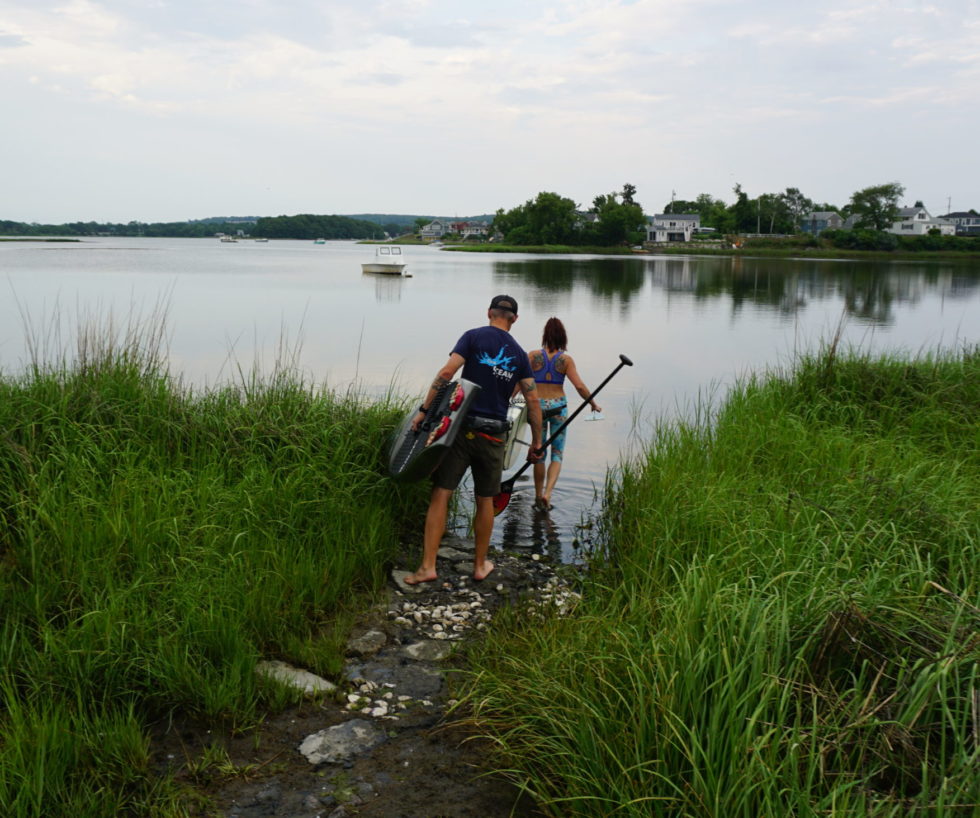ACCESS
Protect and Preserve Shoreline Access

Clean water and healthy oceans are high on our list of priorities, but if we can’t get to the coastline to enjoy ocean activities, then we’ve got a major problem to solve. Limited access to the shoreline is how the organization started in 2006 and to this day it is the most important (but probably least understood) issue that we work on. What started as a simple program related to knocking down obstruction barriers has evolved into an effort that includes topics such as erosion, sea-level rise, invasive species and long term shoreline planning.
Overview of active efforts
MyCoast: Rhode Island - We’re partnering with University of Rhode Island Coastal Resources Center, Rhode Island Sea Grant, the Rhode Island Coastal Resources Management Council, and Save The Bay on a community science effort that’s easy, free, and open to the public. MyCoast: Rhode Island is a portal to collect and analyze pictures and data relating to coastal events. Information collected through this site is used to visualize the impact of coastal hazards and to enhance awareness among decision-makers and stakeholders.
Why Monitor the Shore?
Flooding and erosion tied to strong storms and sea level rise - climate change impacts - change the coast. Documenting the face of this change is one way to collect data that can inform community decisions about how the coast, both natural and developed areas, is protected and maintained in the context of flux.
How Can I Help?
If you have a smartphone, you can participate by snapping pictures and uploading them to the MyCoast RI website. For example, you may choose to share photos of high-tide flooding in your neighborhood, or post-storm damages to roads or other infrastructure at a favorite beach. The website and other MyCoast resources can help you choose sites that are convenient and in need of photos; all we ask that you only take pictures when it’s safe and weather permits!
How to add King Tide or StormReporter reports:
1. Download the free MyCoast App
2. Take your picture, open the app, and click “Add Report.”
3. Select “King Tide” for photos taken of extreme high tides, or “StormReporter” for photos taken of impacts after coastal storms
4. Select photo from library, add comments about the location and any details or damages you observe.
5. Click the map to set your location, and click Submit!
Monitoring of rights of way - Every month the community monitors all fifty rights of way on Aquidneck Island and reports on obstruction, encroachment, vandalism, erosion and other pertinent variables. The data is used either to immediately take action for high priority issues or to keep a constant awareness of the health of the rights of ways. To learn more on how to get involved, please visit our community scientist page.
Adoption of rights of way - Thirty-one of the fifty rights of way on Aquidneck Island have been adopted by Clean Ocean Access in partnership with the Coastal Resources Management Council and the local government, along with Friends of the Waterfront in Newport for the harbor rights of way. Efforts are now underway to adopt the two remaining rights of way in Middletown and the seventeen rights of way in Portsmouth. To learn more on how to get involved, please visit our community scientist page.
Expansion of rights of way - Many rights of way exist on Aquidneck Island that were not officially designated by the Coastal Resources Management Council in their efforts in the 1980’s and 1990’s. We are keenly aware of numerous of fishing locations around Ocean Drive, the west side of the Island, and dozens of town rights of way in Portsmouth. As the Restoration Advisory Board finishes the environmental remediation on the west side of the island, it is imperative that we establish ample public rights of way and adequate parking.
Education and Outreach - Our education and outreach activities are aligned with our community scientist efforts so that a hands-on student-led experience can have the greatest chance of fostering environmentally responsible behaviors and promoting stewardship in our community via action. For complete information about education and outreach opportunities, please visit our education page.
Analytics and Reporting - Data becomes information and information becomes knowledge that informs our decision making to protect and preserve shoreline access. With over fourteen years of access monitoring we have amassed an incredible data set that empowers our organization. All of our data is available for the public and our annual Access and Cliff Walk report can be found on our reports page.
Advocacy – Our main goal is to bring about systemic change is to connect the community with the environment, educating, inspiring, and empowering to foster environmentally responsible behaviors. However, some forms of shoreline access issues require advocacy and policy. For complete information please visit our advocacy action page.
Map of activities
Statistics
Since our first water access issue in January 2006 through the end of 2021, the community has come together to protect and preserve shoreline access.
31 50 5,650
adopted rights-of-way monitoring locations surveys completed
Get involved, volunteer, and become a community scientist
There are many ways to get involved with our efforts to protect and preserve shoreline access, along with our other projects. Please visit our community scientist page.

